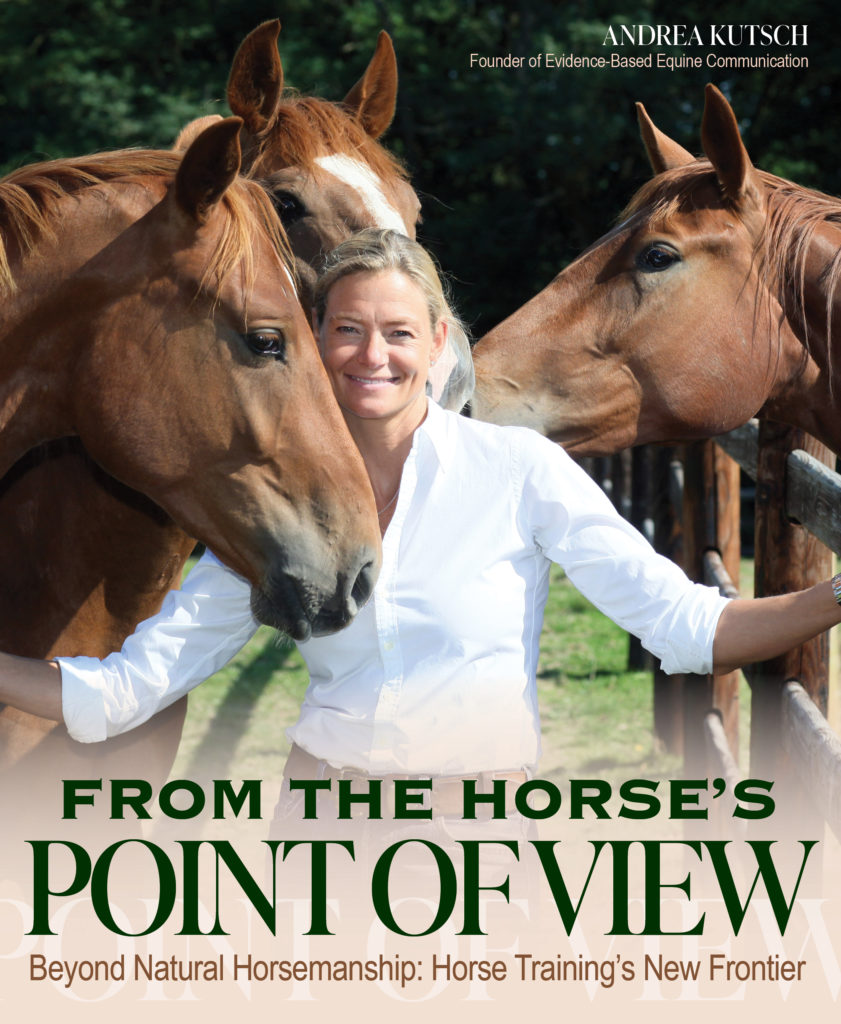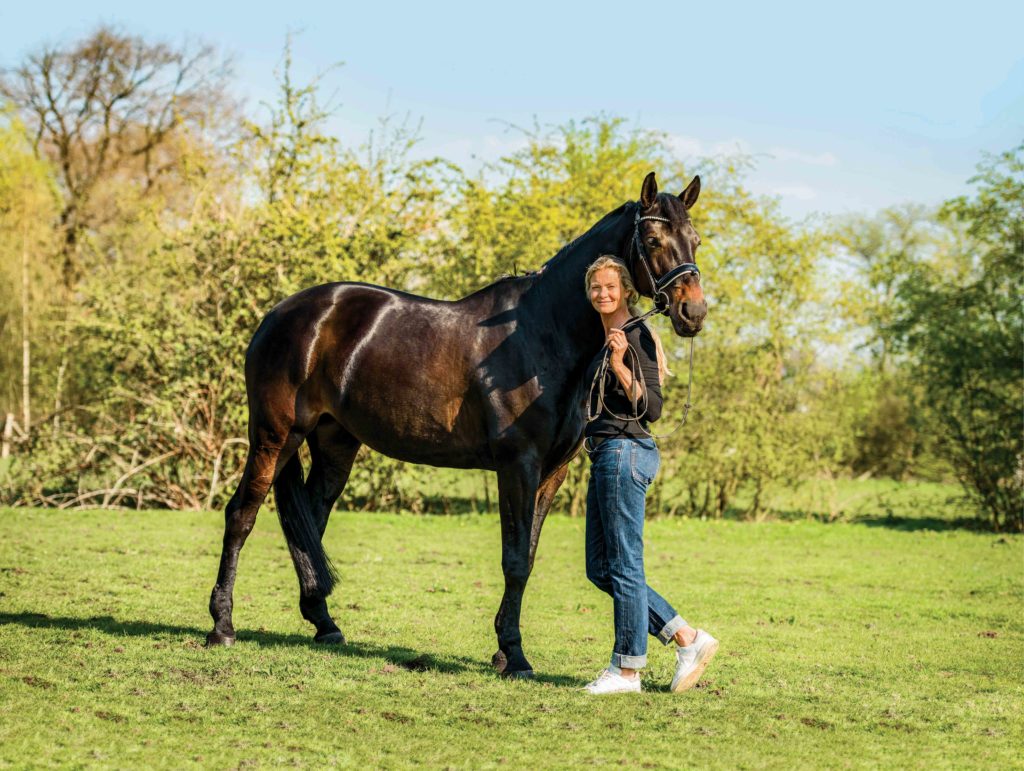Why a “Smack” with the Whip Just Plain Doesn’t Work
In this excerpt from her book From the Horse’s Point of View, founder of Evidence-Based Equine Communication (EBEC) Andrea Kutsch explains why punishing undesired horse behavior never achieves our training and riding objectives.
Let’s assume that a horse doesn’t pick up the canter in response to the leg aid and so he is then punished with the sensory stimulus of a smack with the whip. But at the next attempt, the horse still won’t canter. He still doesn’t show the desired behavior during the subsequent repetitions. The horse doesn’t understand the concept or the stimulus. This is proven by the fact that the behavior doesn’t change. But why doesn’t the horse pick up the canter?
We know that the short-term or primary memory (memory that retains only a small amount of information for a short period of time) needs continuous activity that involves the nerves. When something interrupts the process (for example a smack with the whip or an unexpected distraction), the path to the short-term memory is lost. The short-term memory appears to have a temporal sequence—what goes in first is replaced by what comes in next if it is not repeated often enough (such as when a behavior is learned). In this example where the horse is supposed to respond to the stimulus “smack with the whip” with the behavioral response “canter,” the path that we are trying to lay is deleted with every smack, and we have to start again from the beginning. The horse cannot offer the solution because, in this learning process, the receptors are working against it. The horse might now successfully go forward in response to the tactile stimulus “smack with the whip,” but he will not become any more sensitive to the leg. Many riders then reach for their spurs. This creates a vicious circle. It is rare for riders to abandon their whip and spurs after a few successful repetitions.
Horses often develop a fear of the whip and run away. Then, a strong hand on the reins sometimes gives us a feeling of control. In the meantime, though, everything in the horse’s sensory memory is out of control, so to speak. It can “work” to use a smack with a whip to get the horse to canter, but on the whole, this concept far too often doesn’t work. The risk of producing a horse who is out of control under saddle, be that too fast or too slow, is simply too great. Positive repetitions with an appropriate stimulus are very important for enabling storage in the long-term memory.
When a horse who is supposed to understand the basic leg aids remains still in response to pressure from the rider’s legs or becomes slower and slower the more we intensify the pressure, instead of going forward or going forward faster, he is not unusual. The horse has two problems: He can’t look at another sport horse and copy their behavior, because we have to assume from the latest scientific findings that horses do not have mirror neurons (neurons that fire both when an animal acts and when the animal observes the same action performed by another) that work like ours do. They can observe the behavior of other horses but rarely do they imitate it. And they don’t understand the “game” that we have thought up anyway, because if they did, they would find it easier to do. The concept of moving forward, moving forward faster, or moving forward in a different way in response to a leg pressed against their belly area doesn’t exist in the horse’s world. Watching other horses being ridden can’t enable them to understand riding any better. The horse has no idea what to do with the leg pressure, has never correctly understood a gentle leg aid as it should be, or his instinct is such that it forbids him from yielding to the pressure from the rider’s leg. (The horse naturally initially goes into pressure from the leg, instead of away from it. This is easy to observe especially when starting young horses.)
Going forward to leg pressure is what we humans have come up with, so horses need to learn it. It’s what the whole of equestrian sport is based on. A lasting change in behavior therefore needs to be established on the basis of repetitions. If the horse feels pressure from the rider’s leg in his belly area, it means that he should go forward. He should give this response calmly, to light pressure, because it is likely he will later have to do exercises in response to firmer pressure from the leg. When the horse responds with the behavior of “going forward,” we remove the stimulus. We ensure the transfer from short-term to long-term memory through repetitions.
If we punish the horse with the whip because he is slow or sluggish, or as the vernacular puts it so beautifully, “lazy,” and still doesn’t move in response to increasing pressure from the leg, we are using a punitive stimulus that is extremely difficult for the horse to decode. We also risk exposing the sensitive structure of the skin to pain. Furthermore, it is virtually impossible for the trainer to precisely repeat this response, because repetitions need to be an exact copy of the previous time for the horse’s brain to have a chance of making the connection. If you punish the horse for standing still and a slow response to leg pressure, it is possible that, after he has been ridden for a while, the horse won’t understand that he is supposed to stand still for the rider to dismount—even though he can still feel the rider’s leg. This is incredibly difficult for horses to understand. A very nervous horse can therefore become conditioned to stand still for neither mounting nor dismounting and is always ridden in a state of “alert,” which makes rhythm and suppleness impossible…. A punitive stimulus can trigger all kinds of responses that people are unable to control. The risk of an unwanted behavior is very high.
An exercise only needs to be repeated two to three times to see whether the learning theories have been applied correctly and are working from the horse’s point of view. If the desired behavior occurs repeatedly in response to the chosen stimulus, the aim has already been achieved or the way to achieving the aim has been determined. If nothing changes or the behavior deteriorates, the training plan should be changed. The results of my tests on thousands of horses at Paul Schockemöhle’s Lewitz Stud have been clear: When a training exercise doesn’t work after a few repetitions, the desired learning success won’t be achieved, even after hundreds of repetitions.
This excerpt from From the Horse’s Point of View by Andrea Kutsch is reprinted with permission from Trafalgar Square Books (www.horseandriderbooks.com).


